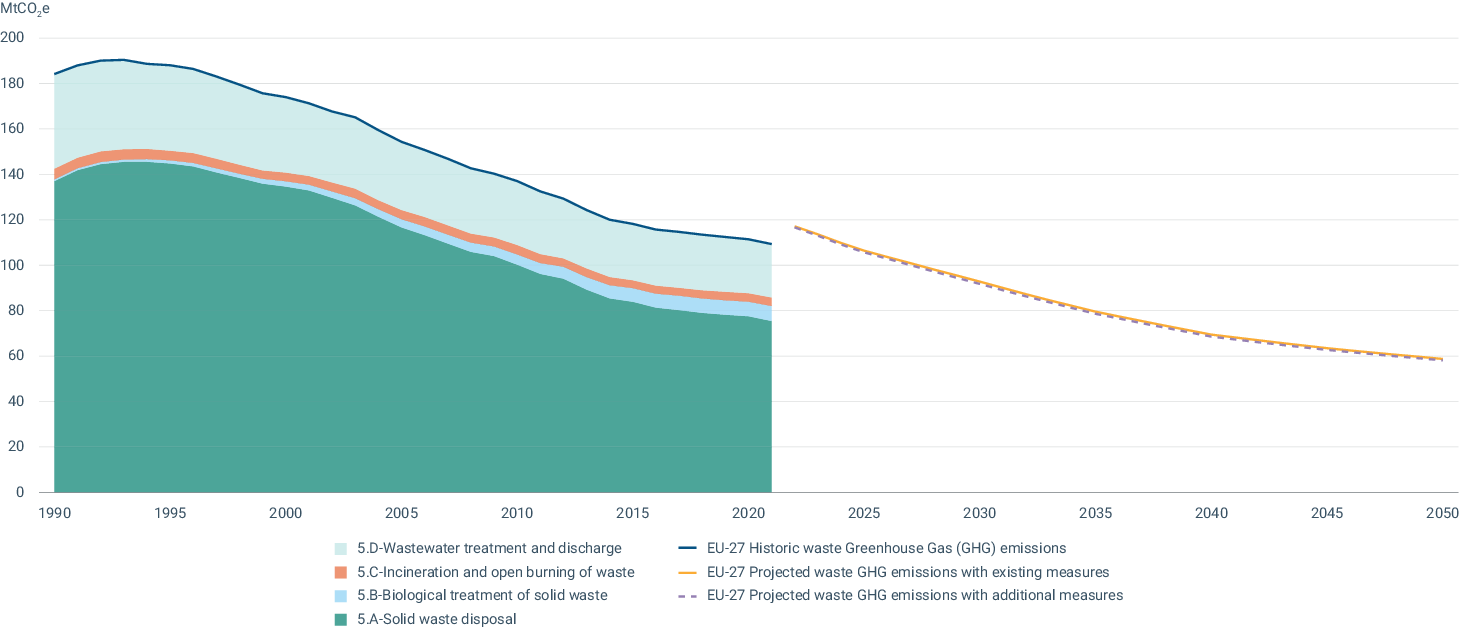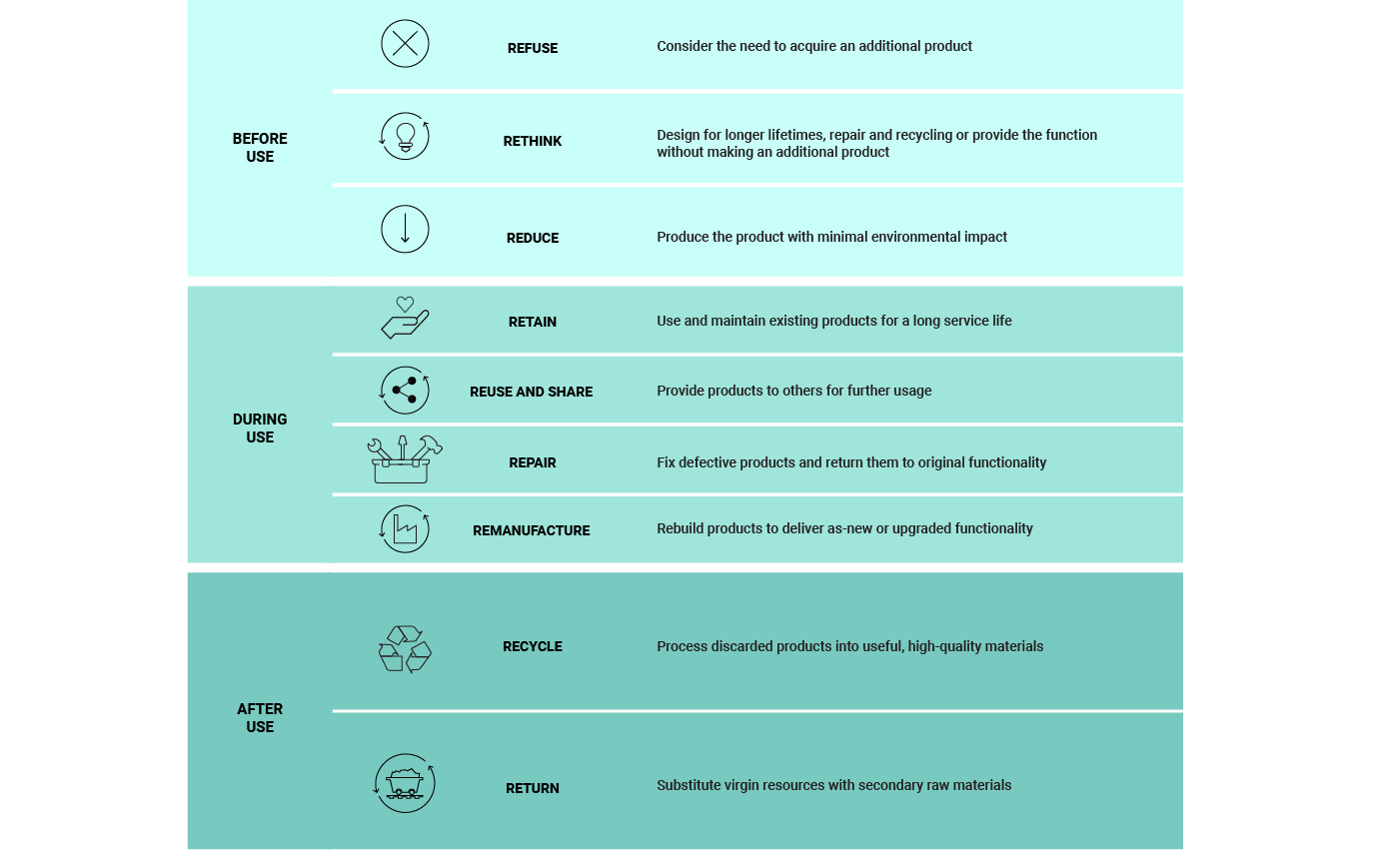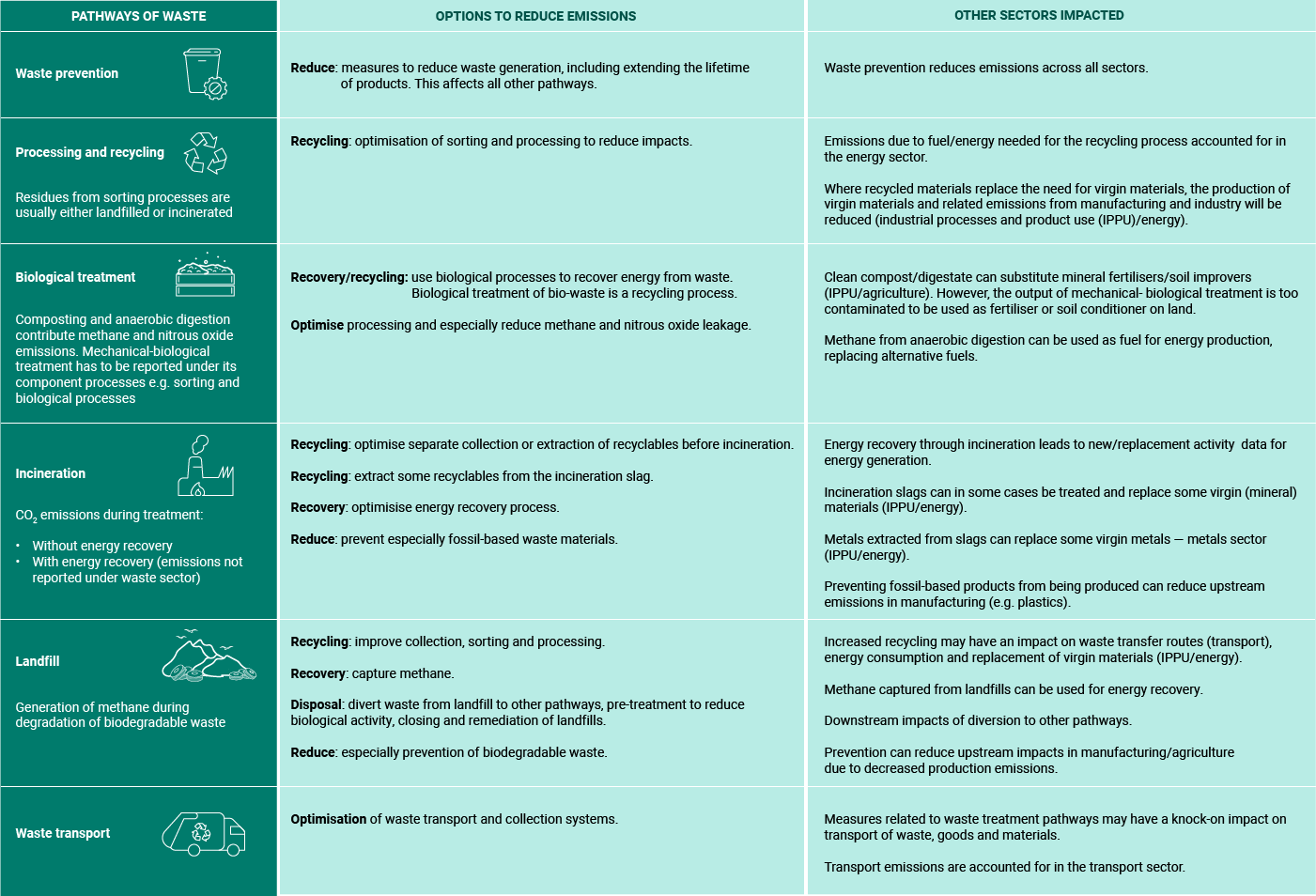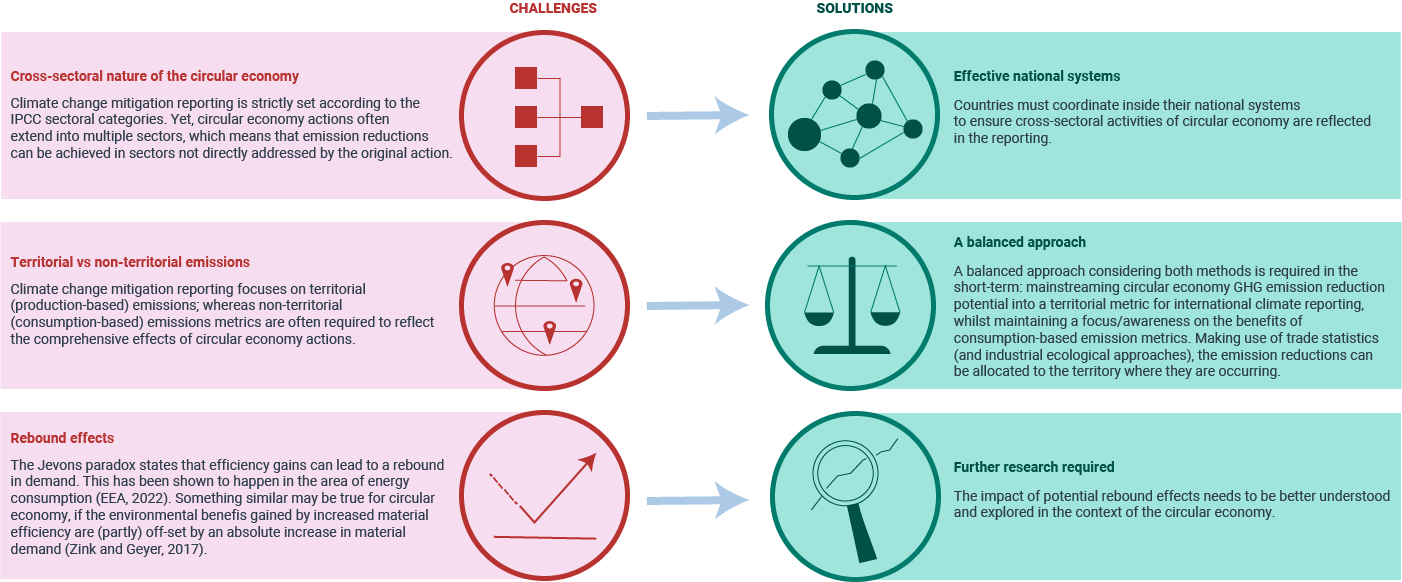Introduction
Achieving the EU’s 2050 net-zero climate target demands actions across economic sectors. These include those actions related to materials and how we produce, use, re-circulate and dispose of them. In this briefing, we explore this dimension further by analysing how European countries include circular economy and waste actions[2] in their reporting on climate change mitigation policies and measures (PaMs)[3] and how the introduction of additional measures can help accelerate future reductions of GHG emissions.
Waste management and the circular economy hold considerable potential for mitigating climate change. Therefore, countries would benefit from including PaMs in these areas as part of their climate policy mix.
The inclusion of such measures in national climate change mitigation reporting can also provide a more comprehensive and transparent account of countries’ climate PaMs. This integration can help reveal key areas where countries could increase mitigation efforts while also increasing circularity and improving waste management. Guidelines for improving interlinkages between these two policy areas and for modelling the national decarbonisation potential of a circular economy are at the end of this briefing.
The briefing is based on the European Topic Centre (ETC) ‘Circular economy and resource use’ and ‘Climate change mitigation’ technical reports Circular economy and climate change mitigation — analysis and guidance on including circular economy (CE) actions into climate change mitigation reporting and policy making and Climate change mitigation through policies on waste — intersectoral analysis.
Circular economy’s potential key role in climate change mitigation
The International Resource Panel (IRP, 2019) highlights that the extraction and processing of materials (fossil fuels, biomass, metals and non-metallic minerals) account for around 50% of global GHG emissions. A key aim of the circular economy is to retain the value of products and materials in use for as long as possible.
This key aim would reduce the demand for virgin materials and the GHGs emitted during their extraction and processing. In addition, the energy-intensive parts of the circular economy should be powered by renewable energy.
This can happen through a series of actions along the whole value chain, including via safe and sustainable design, efficient production, sustainable consumption, longer and better use of products and using waste as a resource (Figure 1). By 2022, about 22 Member States had adopted a dedicated circular economy strategy.
The 2020 circular economy action plan (COM/2020/98 final) of the European Commission recognises this interlinkage between the circular economy and climate policies, presenting circularity as a prerequisite for climate neutrality.
This approach is further acknowledged from the climate perspective, where guidelines for updating national energy and climate plans (NECPs) emphasise the importance for Member States to start ‘integrating and modelling the contribution of the circular economy to the climate transition’.
Source: EEA
The climate benefits of the circular economy are not well captured in climate policies and reporting
The potential emission reductions due to circular economy measures are usually hidden or are not well captured in the reporting of PaMs for reducing GHG emissions. This is partially linked to the disconnect between a strict sectoral reporting structure according to Intergovernmental Panel on Climate Change (IPCC) guidelines and the cross-cutting nature of the circular economy.
For example, if glass waste is collected and processed into recyclables and used as a secondary raw material in producing new glass, then the glass industry needs less energy than that used for producing the same glass from virgin materials. However, such processes are seldom reported as circular economy measures in the relevant manufacturing sector and their potential might be underestimated. Moreover, realising such potential usually requires collaboration along the whole value chain (EEA, 2022a).
Moreover, while returning waste to the economy as recycled materials is a crucial part of the circular economy, measures in the before use and during use stages of a product’s lifecycle are even harder to quantify (Figure 2).
Modelling results show that measures in the before use and during use stages can have even larger GHG emission mitigation potential than measures in the after use or waste phases (Ramboll, Ecologic Institute and Fraunhofer ISI, 2020). Yet, an overview of circular economy policies and measures reported to the EEA (ETC CE, 2022) found that 50% were related to waste (ETC CE, 2024).
A lack of quantifiable data, a focus on the after use stage and the cross-sectoral character of the circular economy might therefore lead to a lack of awareness and underestimation of its potential benefits for reducing GHG emissions.
Source: EEA
Circular economy actions are not explicitly required to be reported under the current policies and measures reporting mechanism. However, they should be more greatly considered as they can offer a substantial potential for emission reductions.
About 148 circular economy related actions were reported — or about 6% of PaMs registered in 2023.[4] These circular economy PaMs do not include those focused on waste-to-energy actions, such as those promoting waste incineration with energy recovery, those converting biowaste to biogas for energy production or technical measures to reduce emissions at landfills.
As indicated in Table 1, a majority of these actions were waste-related entries (60%). The vast majority of PaMs (93%) were reported without quantitative information. By 2030, only 3,070 ktCO2e emission reductions were associated with all circular economy PaMs. This illustrates the large potential for the further inclusion of circular economy into PaMs reporting and the need to be able to quantify the emissions reduction potential of these actions.
Note: Methods for quantifying expected emission reductions differs between Member States. Therefore, numbers regarding ktCO2e are only indicative. Figures are relative to reporting year 2023.
Source: ETC Circular economy and resource use (ETC CE) own classification of the PaMs database (data extracted 24 August 2023).
Greenhouse gas emissions from waste management
While the circular economy spans the whole economy, the waste sector is one of the defined economic sectors reported in GHG inventories and the reporting of PaMs. The waste sector, as defined by the IPCC’s 2006 guidelines (Box 1), was responsible for 3% of European countries’ GHG emissions in 2022.
GHG emissions in the waste sector are generated from the treatment and disposal of solid and liquid waste. Solid waste can be recycled, landfilled, incinerated and can undergo biological treatment.
Methane from landfills accounts for about 70% of the waste sector’s emissions. However, methane emissions decreased by 45% between 1990 and 2021. The waste sector’s emissions in European countries have decreased by 42% since 1990 and are projected to continue declining, with an expected reduction of 58% by 2035 compared to 1990 levels. The EU-27 countries have already achieved a 41% reduction in 2022. If additional policies are implemented, emissions are estimated to fall by 68% compared to 1990 levels (Figure 3).
The EU, its Member States and other European countries regularly prepare and report on historic GHG emissions and removals, projections of future GHG emissions, information on national policies and accompanying measures, descriptions and setups of the national systems for GHG projections and policies and measures.
According to the IPCC 2006 Guidelines, the key sources of waste sector emissions included in GHG inventories are:
- solid waste disposal;
- biological treatment of solid waste;
- incineration and open burning of waste;
- wastewater treatment and discharge (excluded from the analysis).
Emissions from energy recovery of waste, processing recycled materials and transporting waste are not reported in the waste sector but in the energy, manufacturing and transport sectors.
GHG projections are estimates based on modelling exercises that show how GHG emissions could develop in the future. These estimates depend on a number of assumptions affecting these emissions, for example demographic and economic growth, fuel prices and the anticipated effects of PaMs. Different projection scenarios can be used to represent different sets of assumptions, for example by considering, or not, the expected effects of new policies.
A national system for PaMs and projections represents the institutional, legal and procedural arrangements established for reporting. A complete, transparent and stable national system is essential for developing and regularly updating national GHG projections, evaluating climate policy instruments and integrating climate policy with other domains.
National information on GHG emissions, PaMs and national systems are regularly updated, officially reported by European countries under the EU’s Governance of the Energy Union and Climate Action regulation ((EU) 2018/1999) and quality checked and disseminated by the EEA, for example through the ‘Climate and energy in the EU’ website.

Source: EEA data
Click here for different chart formats and data
European countries are committed to adopting, implementing, and planning policies and taking the corresponding measures to reduce GHG emissions in all sectors.
 |
The number of reported PaMs in the waste sector varies considerably across reporting countries. For example, Denmark, France, Hungary and Luxembourg stand out as countries with a high number of such PaMs. However, the number of PaMs alone is not a reliable indicator of effort and/or completeness of national reporting. |
 |
In 2023, there were 218 single PaMs and 15 group PaMs linked to the reported waste sector PaMs. However, only 15% of waste sector PaMs have been quantified and nearly all quantified PaMs refer to the reduction of emissions from landfills. |
 |
For the waste sector, regulatory PaMs are common, reflecting the substantial regulatory requirements in EU waste policy to be met by countries. Most of the reported PaMs affecting the waste sector are linked to EU policy, especially the Waste Framework and the Landfill Directives. |
 |
Much of the GHG emissions reduction in this sector has been achieved so far by measures diverting biodegradable waste from landfills to recycling or energy recovery, and technical measures capturing methane from landfills. Related EU policies have driven such measures forward. |
 |
Waste sector PaMs tend to focus on municipal waste and organic waste types, as these are the wastes generating emissions from landfills and biological treatment. |
 |
Countries that introduced bans on landfilling biodegradable wastes seem to have achieved the largest emission reductions. |
The emission reduction potential is bigger than current projections show. Waste sector emissions could decrease further once all current EU waste policies are fully implemented. Moreover, waste sector GHG emissions would decrease by 53% from the 2021 level if all EU-27 Member States, Iceland, Norway and Switzerland reduced their emissions to the average per-capita solid waste sector emissions of the five best performing countries.
While such a scenario might not be feasible in the short term, it clearly shows that the potential for further emission reductions is substantial. Such actions will also contribute to meeting the objectives of the EU’s strategy to reduce methane emissions (COM (2020) 663 final).
However, the effect of PaMs in the waste sector can be much wider as they can help reduce emissions in other sectors. For example, policies that ensure the collection and processing of waste into recyclable materials can help in the substituting of virgin materials, which usually require more energy to produce than the recycling processes. Cross-sectoral cooperation is crucial to make this happen. For some materials, the markets to feed the recycled materials back into production processes need improvement (EEA, 2022a).
Still, cross-sectoral effects are rarely reflected in the reported PaMs in other sectors than the waste sector as illustrated by Table 2. Table 3 presents an overview of the cross-sectoral impacts and the interconnectedness of waste treatment pathways with waste hierarchy stages and emissions reporting sectors.
Source: ETC CM, 2024 (modified)
Note: IPPU: industrial processes and product use.
Source: ETC CM, 2024 (modified).
Challenges for linking circular economy and climate change mitigation
There are certain challenges for including circular economy actions, including those on waste management, into current IPCC-based reporting schemes. See Figure 4 for an outline of these challenges and their solutions.
Ways forward — a guideline for modelling the decarbonisation potential of the circular economy
Given the potential key role that the circular economy and waste management can have in achieving a country’s climate change mitigation targets, there is clear motivation for better understanding this potential.
Understanding such a potential provides countries with a more comprehensive reporting and may capture some activities countries are already doing to lower their emissions, for example, implementing circular economy policies, but are currently not reported. The six steps below offer guidelines for countries to start or better integrate the decarbonisation potential of the circular economy into climate change mitigation reporting.

Explore the 6 steps here:
Step 1 — Raise awareness and break silos
There is a strong need for raising awareness on the interlinkage between the circular economy and climate change mitigation. Therefore, a first step can be to increase institutional capacity and break silos such that people working on the respective issues gain a better and more detailed understanding of their respective fields. It is also clear that both the circular economy and climate change are cross-sectoral. Thus, subsequent steps in this guideline will need strong coordination between various policy areas and sectors.
Integrating circular economy actors into a country’s national system for reporting is a good means to start this awareness raising. The national system is the organisational overview of who within a country evaluates policy and contributes to reporting and how. Though there is no ‘one-size-fits-all’ solution, countries are encouraged to explore best practices and solutions implemented by other countries. Information on this can be found in the national systems data viewer.
Step 2 — Identify existing circular economy measures with high GHG reduction potential
Getting started — lean approach: this is for countries that are starting to consider the contribution of the circular economy to climate change mitigation. A good starting point is to use existing generic information to identify circular economy actions and sectors with their potential for key climate change mitigation.
This approach could include the UNEP SCP-Hat Tool, the database from the International Resource Panel, the European Commission report Role of the circular economy as a contributor to industry decarbonisation beyond 2030, the Joint Research Centre’s Consumption Footprint Database (Life Cycle Assessment model) and the EEA’s consumption footprint calculations (Exiobase model). These are useful for getting a better understanding of what the climate change mitigation potential is, where the largest potential savings are, and how to start measuring and realising this potential.
Comprehensive approach: this is for countries looking to calculate their actual mitigation potential. It includes the following elements:
- Hotspot analysis — build upon the lean analysis to understand key sectors, industries, material flows and product groups of relevance.
- Circular economy and climate change mitigation plans — use the NECPs to single out which key sectors need further action and then explore what the mitigation potential of the circular economy could be for these sectors.
- Define the scope — clearly define which emissions (territorial only or also non-territorial) and what actions fall under the circular economy and which are better represented by other areas.
- Choose the appropriate methodological approach — this depends on a number of considerations, for example territorial or non-territorial emissions, focus on individual product categories/sectors or the entire economy, static point in time or dynamic view, simple ‘what-if’ scenarios or more complex scenarios. For more guidance see ETC report and (Ramboll, Ecologic Institute and Fraunhofer ISI, 2020).
- Assessment of emission reduction potential — develop a baseline from which the circular economy mitigation potential can be calculated. Conduct the analysis and identify which PaMs make a significant contribution to reducing GHG emissions.
Step 3 — Integrate existing circular economy actions and the quantified resulting emission reduction targets in national climate change mitigation reporting
Based on the previous steps, concrete information on the reduction potential of already existing PaMs in relevant sectors and policy areas would be available. This allows them to be included in climate change mitigation reporting (NECP/NDC and PaMs biennial reporting).
For PaMs biennial reporting consider key structural pieces of information that need to be reported in such an exercise. These could include information on Energy Union dimensions and objectives targeted, sectors targeted, quantified targets, indicators used to monitor the PaMs, and the quantified emission reductions achieved and expected. See PaMs reporting guidelines for detailed information on what is to be reported. Effective coordination within a country’s national system can help to ensure all actors are aware of what information is required at this step.
Step 4 — Analyse if further legislative proposals are needed
Circular economy actions already included in strategies, action plans or legislation can be included in climate change mitigation reporting (Step 3). However, once the GHG reduction potential has been identified (Step 2), the analysis of effective circular economy actions may also lead to the conclusion that further legislative action is needed. This could include amending existing legislation to improve its mitigation potential or proposing new legislation.
Step 5 — Monitor progress
It is necessary to identify or develop indicators that allow the monitoring of GHG reductions achieved through circular economy actions. The model (Step 2) may provide an estimate for potential savings, while this step follows up with ex-post assessments that can help monitor the GHG emissions savings achieved. National authorities can do this by developing specific data streams or a series of indicators, for example those used by the EEA’s Circular Metrics Lab. This information is a key part of climate change mitigation reporting and should be integrated into future reporting cycles.
Step 6 — Institutionalise and continue to develop method
After a successful first effort in integrating circular economy actions in climate change mitigation reporting, continuous institutionalisation is the goal (restarting from Step 1). This includes reflecting on the previous cycle of reporting, refining the national system to be as robust and effective as possible, developing knowledge and capacities in regard to modelling approaches, and ideally introducing mandatory ex-ante/ex-post evaluations of policies and measures. The final goal is the mainstreaming of circular economy actions in climate change mitigation policy, and vice versa.
Notes
[1] European countries: the EU-27, Iceland, Norway and Switzerland.
[2] Actions is used as a generic term for a broad range of activities related to circular economy.
[3] ‘Policies and measures’ (PaMs) mean all instruments that contribute to meeting the objectives of the integrated national energy and climate plans (NECPs) and/or to implement international climate commitments under UNFCCC and Paris Agreement, which may include those aiming at reducing of greenhouse gas emissions in the waste sector. All EU Member States are required to report information on implemented, adopted, or planned integrated national climate and energy PaMs under the Governance of the Energy Union and Climate Action Regulation. This officially-reported information is quality-checked by the EEA and is used to monitor climate action at the national level.
[4] For details on methodology see ETC technical reports Circular economy and climate change mitigation — analysis and guidance on including circular economy (CE) actions into climate change mitigation reporting and policy making.
References
EC, forthcoming, Role of the circular economy as a contributor to industry decarbonisation beyond 2030, European Commission.
EEA, 2022a, Investigating Europe’s secondary raw material markets, EEA report No. 12/2022, European Environment Agency (https://www.eea.europa.eu/publications/investigating-europes-secondary-raw-material) accessed 9 November 2023.
EEA, 2022b, ‘The Jevons paradox for energy consumption in the EU-27, 1995-2019’, European Environment Agency (https://www.eea.europa.eu/data-and-maps/figures/the-jevons-paradox-for-energy) accessed 8 November 2023.
ETC CE, 2022, Circular economy country profiles, ETC/CE Reports 2022/5, European Topic Centre on Circular economy and resource use (https://www.eionet.europa.eu/etcs/etc-ce/products/etc-ce-reports-2022-5-circular-economy-country-profiles-a-set-of-30-country-profiles-that-summarise-policies-and-initiatives-in-the-area-of-circular-economy) accessed 20 November 2023.
ETC CE, 2024, Circular economy and climate change mitigation - guidance on including Circular Economy (CE) actions into climate reporting and policy making, European Topic Centre on Circular economy and resource use, ETC CE report No. 2024/01, (https://www.eionet.europa.eu/etcs/etc-ce/products/etc-ce-report-2024-1-circular-economy-and-climate-change-mitigation-analysis-and-guidance-on-including-circular-economy-actions-in-climate-reporting-and-policy-making) accessed 22 February 2024.
ETC CM, 2024, Climate change mitigation through policies on waste – intersectoral analysis, European Topic Centre on Climate change mitigation, ETC CM report No. 2024/01, (https://www.eionet.europa.eu/etcs/etc-cm/products/etc-cm-report-2024-01/view) accessed 15 February 2024.
IRP, 2019, Global Resources Outlook 2019: Natural Resources for the Future We Want, International Resource Panel, United Nations Environment Programme. Nairobi, Kenya (https://www.resourcepanel.org/reports/global-resources-outlook) accessed 18 October 2023.
Metabolic, 2022, Circular Agrifood – Potential of Circular Economy Actions to reduce Greenhouse Gas Emissions (https://www.metabolic.nl/publications/circular-agrifood/) accessed 10 January 2024.
Ramboll, Ecologic Institute and Fraunhofer ISI, 2020, Quantification methodology for, and analysis of, the decarbonisation benefits of sectoral circular economy actions, (https://brandcentral.ramboll.com/share/Ntjri6mNKZonSD19BGCH) accessed 15 November 2023.
Zink, T. and Geyer, R., 2017, 'Circular Economy Rebound', Journal of Industrial Ecology 21 (3), pp. 471-795 (https://doi.org/10.1111/jiec.12545).
Identifiers
Briefing no. 25/2023
Title: Capturing the climate change mitigation benefits of circular economy and waste sector policies and measures
EN HTML: TH-AM-24-002-EN-Q - ISBN: 978-92-9480-626-0 - ISSN: 2467-3196 - doi: 10.2800/512574
EN PDF: TH-AM-24-002-EN-N - ISBN: 978-92-9480-625-3 - ISSN: 2467-3196 - doi: 10.2800/59694










Document Actions
Share with others